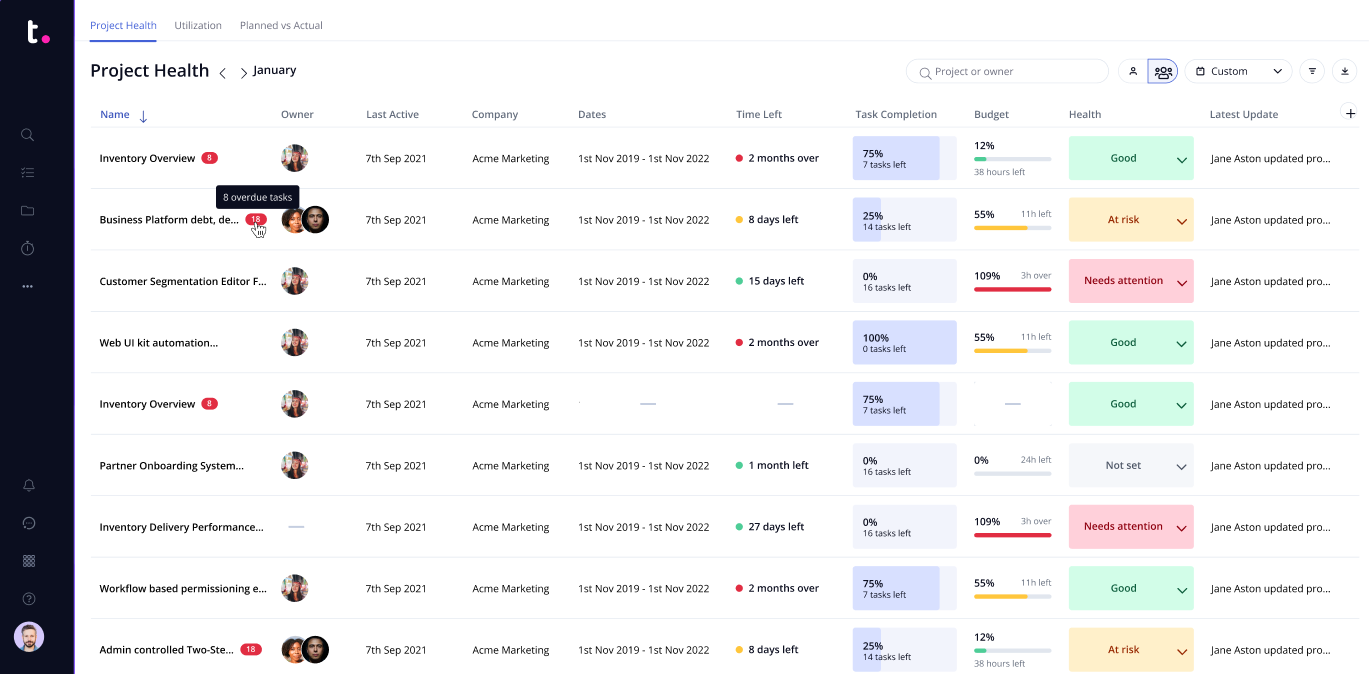Table of Contents
No project manager is an island.
A project is a collaborative effort. Even though you’re in charge of managing it, in order for the project to be successful you still need to rely on, work with, and report back to other people.
Throughout this guide, we’ve been talking a lot about the various people involved in taking a project from idea to execution: your team, other departments within the organization, leadership, clients, and more.
These people are your project’s stakeholders. But what does that mean, exactly? How do your stakeholders affect your project? And what can you do to keep them happy?
What is the definition of a project stakeholder?

According to the Project Management Institute, project stakeholders are defined as:
“Individuals and organizations who are actively involved in the project, or whose interests may be positively or negatively affected as a result of project execution or successful project completion.”
In other words, your project’s stakeholders are the people or groups who have something to gain (or lose) from your project’s outcome.
Okay but really: what is a stakeholder in project management?
So according to the project stakeholder definition above, a stakeholder is anyone with an interest or investment in your project. But what does that actually look like in practice?
Your stakeholders are a varied group, with varied interests. (If you’re playing on Hard Mode, they might even have completely conflicting interests that you need to balance — fun!)
The only all-in-one platform for client work
Trusted by 20,000 businesses and 6,000 agencies, Teamwork.com lets you easily manage, track, and customize multiple complex projects. Get started with a free 30-day trial.
Not only that, but the list of stakeholders can change throughout the project’s journey: a certain stakeholder’s influence might become more or less important depending on the project phase, for example.
Your job as a project manager is to keep all stakeholders informed, involved, and on-board throughout the project’s progression. Stakeholder happiness is one of the key metrics of a successful project, so making sure you get the right buy-in and tick the right boxes — at the right times — is crucial.
Ultimately, managing those complex stakeholder relationships is one of the key skills of a project manager. But with so many different interests, perspectives, and personalities to juggle, it’s no easy feat.
Here’s what you need to know about your stakeholders: who they are, what they do, why they matter, and how to work with them.
Who are the stakeholders in a project?
Now that you know the answer to the question “what are project stakeholders”, the natural next question is “who are the stakeholders in a project”.
As we’ve already seen in the project stakeholder definition above, a stakeholder is anyone with an interest or investment in your project. But when you actually start to map that out, you might be surprised by how long the list can be.
That’s because investment in your project can take a number of different forms. It can be the company’s money, an executive’s sponsorship or a manager’s resources. It can also apply to the end user or customer, as their needs are a critical consideration when it comes to steering your project.
Let’s take a closer look at some of the different kinds of stakeholders in a project.
Types of stakeholders in project management
There are two main types of stakeholders in project management, internal and external.
Internal stakeholders
These stakeholders are coming from within the house!!! Internal stakeholders are people or groups within the business, such as team members, managers, executives, and so on.
External stakeholders
External stakeholders are — as you can probably guess — people or groups outside the business. This includes customers, users, suppliers, and investors.
As you can see, stakeholders don’t always work for the project manager. Needless to say, this can add an extra layer of complexity, as you need to be able to communicate with people at all different levels of the business and with varying degrees of engagement, influence, and interest.
Examples of stakeholders in a project
The stakeholders in each particular project will vary depending on the type of project and industry, but here are a few examples of the types of stakeholders in project management you might need to consider:
Project manager
Team members
Managers
Resource managers
Executives
Senior management
Company owners
Investors
Sponsors
Financiers (the people, not the cakes)
Suppliers
Vendors
Consultants
Customers
End users
So how do you know which stakeholders you need to focus on for your particular project? For that, you need to do a stakeholder analysis.
How to do a stakeholder analysis
As soon as your project charter is complete and the scope of your project is defined, you can use it to start mapping out your stakeholders. Here’s how to get the ball rolling with a basic stakeholder analysis process.
1. Identify your stakeholders
First step, you need to identify who your stakeholders actually are. To do this, draw on your project charter and any other project plans and documentation to compile a full list of your project stakeholders, both internal and external.
Bear in mind that some stakeholders won’t come into play until later in the project lifecycle — but if you can anticipate who they’ll be in advance, you can start to get their buy-in, build the relationship from the outset, and help them to feel involved from the beginning.
2. Prioritize your stakeholders
Once you’ve identified all of your stakeholders, you can start to prioritize them.
Prioritizing your stakeholders is important because it helps you understand where to invest your resources. In other words, it helps you — as the project manager — to identify who the key decision makers are at any given moment, so you can ensure that you’re talking to the right people, at the right time.
There are a few methods of doing this stakeholder prioritization, but one simple way is to plot them out using a power/interest (or power/influence, or impact/influence) grid.
The power/interest grid helps you to identify your key stakeholders by answering two key questions that help you to group them into one of four categories:
What level of power do they have?: How important is it that they’re happy with the project’s progress and results? How integral are they to the project’s success? How influential are they to the project, to other stakeholders, to the team, and so on? (Remember: a stakeholder’s influence can be positive or negative!)
What level of interest do they have?: Is this project super important to them, or are they only tangentially connected to it? Is it something they’re directly accountable for? Are they reliant on it for other work or results? Are they opposed to the project or concerned about it in some way?

As we can see from the (highly technologically-advanced) matrix above, stakeholders who fall into the top-right quadrant (powerful + interested) are the ones you should be giving extra attention to, because they’re the ones who can have the most impact on your project — for better or for worse.
3. Understand your stakeholders
Now that you know who the key players are and which ones to prioritize, you need to get a full grasp of their expectations for the project.
For key stakeholders, this might involve meeting up for a short face-to-face interview or conversation where you discuss things like:
What their definition of project success looks like
Any concerns or reservations they have about the project or its outcomes
What their expectations for the project are
What impact a positive or negative project outcome would have on them
Whether there are any anticipated conflicts of interest with other stakeholders that you need to be aware of
Not only will these conversations help you to understand each stakeholder’s involvement in, and outlook on, the project, but it also helps you to build a bigger picture of your stakeholder network and how each stakeholder interrelates.
And on a personal level, meeting with the key stakeholders at the beginning of the project helps you to feel out some basic interpersonal preferences (like communication style), as well as start building your relationships with each stakeholder.
As you’re doing this, it’s also helpful to keep your eyes open for any political, cultural, or environmental cues, if you can. Picking up on things like the political climate of the organization, how your key stakeholders interact with each other, and any potential conflicts of interest can help to give you some essential context when it comes to running your project or pre-empting certain decisions — and it’s a project manager superpower that you should start cultivating as soon as possible.
How to manage your project stakeholders
Identifying your stakeholders and their needs is just one piece of the stakeholder management puzzle. But it doesn’t end there. For a successful project, your key stakeholders’ requirements, project objectives, and happiness should be an ongoing concern throughout your project.
Now, that doesn’t mean that the stakeholder is always right — and your job as a project manager will sometimes involve pushing back on your stakeholders and re-balancing their expectations with the project charter and project plan you all agreed on at the start.
The tricky part is in balancing everyone’s needs, requirements and objectives so you can keep your stakeholders happy — while also delivering the project you set out to deliver.
Here are a few ways you can establish some best practices for stakeholder management and develop better stakeholder relationships at every phase of your project.
Document each stakeholder’s roles and needs
All that work you did identifying your stakeholders and their individual needs in relation to your project? Put it to good use by compiling it into a shared, accessible document to make sure you have a record of everyone’s role and responsibilities and keep you all on the same page.
Creating a stakeholder register for your project helps you to keep track of a long list of people and priorities. With a definitive document you can update, edit, and consult as your project progresses, you can ensure that you’re always driving the project in the right direction and keeping the right people informed at the right times.
And speaking of which…
Communicate with your stakeholders

As a project manager, keeping your stakeholders informed, included, and inspired throughout the lifecycle of your project is one of your most important jobs.
As mentioned above, your “priority” stakeholders will probably shift depending on which phase of your project you’re at. That’s a good thing, allowing you to direct your energy where it’s needed and avoid overloading people with irrelevant information.
That’s important, because while you want to give your stakeholders visibility, over-communication can be just as frustrating as under-communication.
Using a project management tool with lots of different communication options means that you can tailor your notifications to each stakeholder’s unique needs, while still keeping a full audit history of every action and decision (which is especially handy when it comes to reporting time).
Get started with Teamwork Chat
Start working together beautifully. See how Teamwork Chat
can help your team with our 30-day free trial.
Give project stakeholders visibility over what matters to them

Help each stakeholder to cut through the noise and get immediate insights into the metrics that are most important to them by creating custom Dashboards. Build personalized Dashboards with panels to keep track of your team management: tasks, project statuses, team activity, milestones, risks, and more, so your stakeholders can quickly see how certain parts of the project are progressing and get an immediate overview of the information they care about at a glance.
Stakeholders shouldn’t be an afterthought. Instead, build them into your project from the beginning, by communicating regularly, keeping them up-to-date and involved, and ensuring they feel valued and listened.
Project stakeholders: FAQ’s
How do you identify project stakeholders?
Identifying project stakeholders involves a systematic process that begins with reviewing project charters and existing documentation. It categorizes stakeholders into internal and external groups, distinguishing between direct and indirect, and positive and negative stakeholders. Stakeholder workshops, interviews, brainstorming, and expert input are valuable techniques for gathering insights, while specialized tools and templates can aid in organizing and prioritizing stakeholders. The process is dynamic and evolves as the project progresses, ensuring that all relevant parties, both obvious and less apparent, are recognized and their interests, needs, and expectations are considered throughout the project lifecycle.
What challenges can arise when managing stakeholders?
Managing stakeholders in a project can present challenges such as diverse expectations among stakeholders, the risk of scope creep due to changing demands, communication gaps leading to misunderstandings, resistance to project changes or Agile adoption, unclear roles and responsibilities, and the potential for unidentified or unengaged stakeholders. These challenges require proactive and effective communication, a clear understanding of roles, and strategies for managing conflicting interests to ensure stakeholders' needs are met, and project success is achieved.
How can you effectively communicate with project stakeholders?
Effective communication with project stakeholders involves a systematic approach that begins with identifying stakeholders and understanding their needs and expectations. It requires clear, concise, and tailored messaging, using various communication channels and formats to reach different stakeholders effectively. Regular and transparent updates, including progress reports, issue resolutions, and risk assessments, help maintain stakeholder engagement. Additionally, active listening, empathy, and responsiveness to stakeholders' concerns and feedback foster trust and collaboration. Finally, establishing a communication plan that outlines roles, responsibilities, and communication frequencies ensures that stakeholders are informed and engaged throughout the project lifecycle.
What strategies can you use to engage stakeholders throughout the project?
Engaging stakeholders throughout a project involves strategies such as early and continuous involvement through workshops, interviews, and feedback sessions, ensuring their voices are heard in decision-making processes. Developing a clear and shared project vision and objectives can align stakeholders' interests and motivation. Regular and transparent communication, including progress updates and issue resolution, maintains their engagement. Involving stakeholders in risk assessments and mitigation planning shows their concerns are taken seriously. Providing opportunities for active participation and recognizing their contributions fosters a sense of ownership and commitment, ultimately enhancing stakeholder engagement throughout the project.



